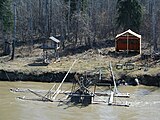
Artisanal fishing
Artisanal fishing (or traditional/subsistence fishing) consists of various small-scale, low-technology, low-capital, fishing practices undertaken by individual fisherman (as opposed to commercial fishing).[1] Many of these households are of coastal or island ethnic groups. These households make short (rarely overnight) fishing trips close to the shore. Their produce is usually not processed and is mainly for local consumption. Artisan fishing uses traditional fishing techniques such as rod and tackle, fishing arrows and harpoons, cast nets, and small (if any) traditional fishing boats. For that reason, socio-economic status of artisanal fishing community has become an interest of the authorities in recent years.
Artisan fishing may be undertaken for both commercial and subsistence reasons. It contrasts with large-scale modern commercial fishing practices in that it is often less wasteful and less stressful on fish populations than modern industrial fishing. Target 14.b of Sustainable Development Goal 14 works to provide access rights to artisanal fishers on marine resources and markets.[2]
Importance[edit]
Hundreds of millions of people around the world rely on artisanal fisheries to live. Artisanal fishing is critically important for not only food, but for jobs, income, nutrition, food security, sustainable livelihoods, and poverty alleviation as well.[3][4] Artisanal fisheries are the predominant form of fisheries in "tropical developing countries" such as Nigeria.[5]
The importance of artisanal and small-scale fisheries have been recognized in the first internationally agreed instrument dedicated entirely to small-scale fisheries. This agreement, drafted by the Food and Agriculture Organization of the United Nations is titled the Voluntary Guidelines for Securing Sustainable Small-Scale Fisheries in the Context of Food Security and Poverty Eradication and was implemented in 2015.[6] In addition, there is increased global advocacy to provide access for small-scale artisanal fishers to marine resources and market, this is one of the major targets of the United Nations Sustainable Development Goal 14.[7]







